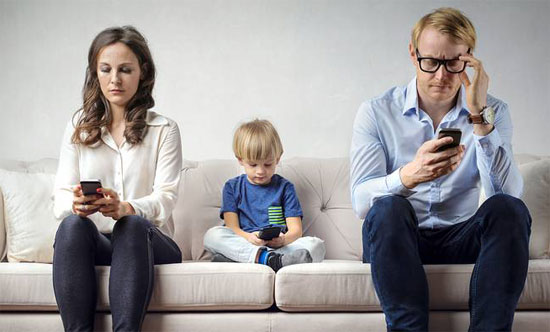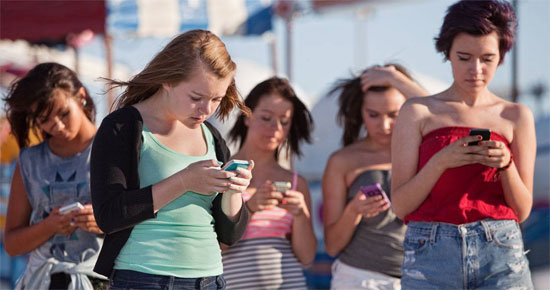The End of a Generation: Young People on the Verge of Madness Due to Smartphones

Technology, such as smartphones, have become a vital part of our day to day living and are negatively impacting our society and having unintended consequences.
Something we’ve observed is that these phones are keeping families from truly engaging in family time, as we once knew it.
Dinner used to be the time when a family sat down together and shared their experiences of the day, but this now is something of the past. Go to any restaurant and you will see entire families sitting at tables, their eyes glued to their phones, no one talking or even making eye contact with each other.
Research is now revealing that smartphones are having detrimental mental health effects on our youth. San Diego State University professor of psychology, Jean Twenge has claimed that smartphone usage is having a radical impact on both the behavior and mental health of U.S. teenagers.
Dr. Twenge stated: “The arrival of the smartphone has radically changed every aspect of teenagers’ lives, from the nature of their social interactions to their mental health. Rates of teen depression and suicide have skyrocketed since 2011.
It’s not an exaggeration to describe iGeneration as being on the brink of the worst mental-health crisis in decades. Much of this deterioration can be traced to their phones.”
This goes beyond teens spending too much time staring at their phones. Dr. Twenge has plenty of hard data to support her contentions – made in The Atlantic, the magazine in which Laurene Powell Jobs bought a majority stake.
A 2017 survey of more than 5,000 American teens found that three out of four owned an iPhone.
The surveys show that teens today spend far less time hanging out with their friends, fewer of them have a driving license, they date less, make love less, get less sleep and are more likely to feel lonely.
It appears that smartphones are adversely impacting the normal stages of child and teenager development and socialization.
More stark statistics from Dr. Twenge’s article
Teens who spend three hours a day or more on electronic devices are 35 percent more likely to have a risk factor for suicide, such as making a suicide plan.
Boys’ depressive symptoms increased by 21 percent from 2012 to 2015, while girls’ increased by 50 percent.
The rise in suicide, too, is more pronounced among girls.
Although the rate increased for both sexes, three times as many 12-to-14-year-old girls killed themselves in 2015 as in 2007, compared to twice as many boys.
The suicide rate is still higher for boys, in part because they use more-lethal methods, but girls are beginning to close the gap.
Twenge notes that smartphones are not the only factor, but she argues that it is a key one.
“Parenting styles continue to change, as do school curricula and culture, and these things matter.
But the twin rise of the smartphone and social media has caused an earthquake of a magnitude we’ve not seen in a very long time, if ever.
There is compelling evidence that the devices we’ve placed in young people’s hands are having profound effects on their lives — and making them seriously unhappy.”

And far from the common belief that kids grow up too quickly these days, she argues that the opposite is true when you examine common markers like going out without their parents, earning their own money and starting to date.
Across a range of behaviors — drinking, dating, spending time unsupervised — 18-year-olds now act more like 15-year-olds used to, and 15-year-olds more like 13-year-olds. Childhood now stretches well into high school.
The piece is illustrated with depressing examples of behavioral changes.
“One of the ironies of iGeneration life is that despite spending far more time under the same roof as their parents, today’s teens can hardly be said to be closer to their mothers and fathers than their predecessors were. I’ve seen my friends with their families — they don’t talk to them,” teenager Athena told. “They just say ‘Fine, whatever’ while they’re on their phones. They don’t pay attention to their family.”
Like her peers, Athena is an expert at tuning out her parents so she can focus on her phone. She spent much of her summer keeping up with friends, but nearly all of it was over text or Snapchat. “I’ve been on my phone more than I’ve been with actual people,” she said. “My bed has an imprint of my body.”
There’s the now common portrait of social media usage making people feel unhappier as they compare their own lives with the self-curated online version of the lives of their peers.
Today’s teens may go to fewer parties and spend less time together in person, but when they do congregate, they document their hangouts relentlessly — on Snapchat, Instagram, Facebook.
Those not invited to come along are keenly aware of it.
Accordingly, the number of teens who feel left out has reached all-time highs across age groups. Like the increase in loneliness, the upswing in feeling left out has been swift and significant.
Dr. Twenge doesn’t have any easy answers to this growing crisis. She acknowledges that it’s not realistic to expect teens to dramatically curtail their usage of electronic devices or social media. But she suggests that modest changes could help.
Significant effects on both mental health and sleep time appear after two or more hours a day on electronic devices.
The average teen spends about two and a half hours a day on electronic devices. Some mild boundary-setting could keep kids from falling into harmful habits.
yogaesoteric
March 4, 2019
Also available in:
 Français
Français
